Did you know that the original, generic term for fabric roller shades seems to have been “Holland shades” or simply “Hollands”? I recently purchased a bundle of vintage decorating catalogs on ebay, and buried in the bunch were these two samples of “Bancroft’s Sun-Fast Hollands” for window shades. When I noticed this archaic terminology, I went looking for more info on its history and use.
Holland shades
From vintage advertisements and other sources, it seems clear that “Holland shade” or “Hollands” was a generic term for a roller shade for much of window covering history, all the way through the middle of the 20th century.
Here is what I have pieced together:
- Before 1725, so-called Holland cloth — heavy duty linen — seems to have been commonly used to make fabric shades for windows.
- In 1725, a Scottish weaver, James Louis Robertson, started using the cloth to make window shades. According to this history — the most extensive I found — in 1774, he created a new process to make the fabric even more durable and to take on a glazed effect that was noteworthy for centuries to come. In a process that took a full 10 days — and a Newfoundland dog! — Robertson stretched and rolled and pressed the fabric until the linen threads sort-of mushed together. The fabric looked polished. The Robertson fabrics were called “Scotch Holland” shades. And, there was soon a second manufacturer, John King. Today, the Scottish Holland Blind Company makes blinds using the same basic technique (sans Newfy, I presume), although they seem to use cotton rather than linen.
- Here’s another article by Gordon that describes how the fabric was prepared. He says that Scotch Holland fabric continued in production until the 1980s!
- Despite the innovative Scottish manufacturing techniques that made this fabric and the window shades famous, the narrower term “Holland shades” seems to be the one that stuck.
- By the 18th century, Hollands were popularized into other European countries. See an 18th century example of a “curtain paper” in the Cooper-Hewitt’s collection. Okay so here is where I also am confused, reading through these online clues: Were paper shades called “curtain papers” and “Hollands” only referred to cloth? I will say: Yes, Hollands only refer to the polished linen shades or those that simulate that look.
- Once these caught on, other types of threads (not just linen) were also used for the shade, but the term “Holland shade” stuck, no matter what the cloth.
- This story has additional interesting history and images. Renoir painted Holland shades!
- The roller shade mechanism that we know today was not patented until 1864, when, building on his family’s earlier patents, Stewart Hartshorn (<– click that one to see the family-written history) received patent number 44,624 for an improved design introducing the rachet and gravity pawl. This design remained the standard for decades to follow. One of many Stewarts in the family lineage, this Stewart also grew to run the company business — Stewart Hartshorn Co. — which I see extant as early as 1908 and which grew quite large and prosperous. I cannot find any information online about when the company ceased manufacturing, I can see it up until 1939 in the family history. Interestingly: This Hartshorn ad calls the cloth they were using a different fabric that they dubbed “Joanna Cloth”.
Above: A 1936 copyright entry in the Library of Congress for Bancroft’s Sun-Fast Holland. This story indicates that Bancroft Hollands were made with cotton. Here’s another book with more history about Bancroft and their processes. Note: My Bancroft samples do not “feel” like fabric — they feel very plasticized. Its seems that they were not stingy with the pyroxylinglazing.
So could you follow all that? So let’s not call them window shades or roller blinds any more — let’s revive Hollands!
Other archaic terms we’ve researched — and before you click through — test your Retro Renovation knowledge — do you know what home products they refer to?:
- Hudee WHAT?
- Pickwick WHAT?
- Fingerblock WHAT?


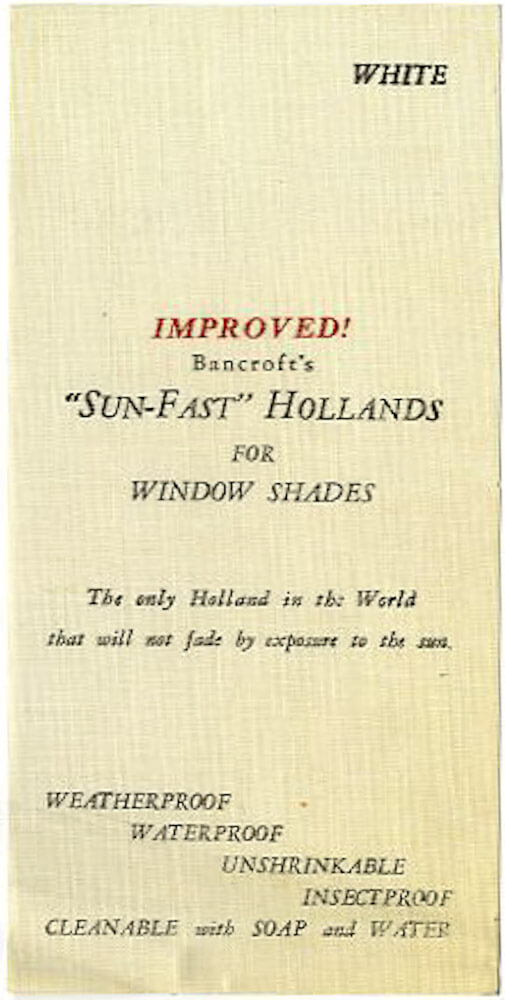



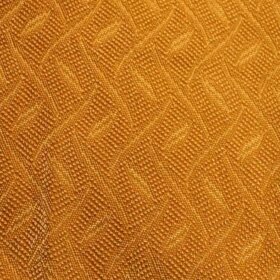
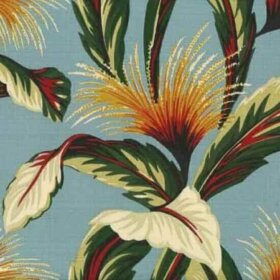
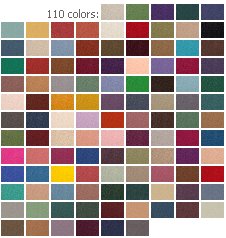
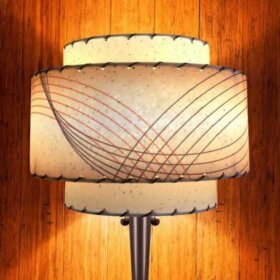
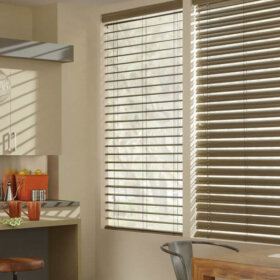

Lisa Compo says
I just HAD to read the history of the cloth…dying of curiosity on how the dog was involved. What an interesting story. It’s always so fun to learn about things you never gave thought to before.
I love roller shades “Hollands” (although mine are vinyl) they are up out of the way and stay so much cleaner than mini blinds. Some day….eventually I am going to get rid of all the plastic dust catcher mini blinds here and get shades or sheer curtains for privacy. But hey, I have a 1996 house, mini blinds are “standard” LOL.
Bonnie says
“Holland” struck an immediate chord with me, but what it reminded me of was “Holland pockets.” I Googled that and immediately was directed to Jane Eyre, a book I have read many, many times. This link not only mentions holland pockets, but holland pinafores AND holland shades! Cool!
http://www.verbalworkout.com/ub/ub102/ub10215920.htm
GlenEllyn says
We had fingerblock in the living and dining rooms in one of our 1960s-era homes when I was grade school. Believe it or not, now (courtesy of the previous owner) I have it in the bathroom of my present home, built in 1926. I can only guess it was a budget decision when they had to redo the floor – they lived here for nearly 35 years. It’s in good shape – it just looks strange in there.
My house still has plenty of original features, such as the icebox in the exterior wall of my tiny kitchen. It had outside access for the ice man. The previous owners used it as a liquor cabinet until they noticed their supply suspiciously dwindling. Apparently some neighborhood “kids” had discovered their stash and helped themselves. When the house was re-sided, the outside access was covered. It’s no longer usable but the wood doors add such nice character that I’ll never remove them.
pam kueber says
Great story!
Amy Queen says
Hi Pam, I have Hartshorn rollers in my house trademarked 1900. They are fragile but I have been mending them
Pam Kueber says
Very cool!
Mary Elizabeth says
GlenEllyn, I am so old (born in the 1940s) that I remember those older homes with ice boxes that had both an inside and outside access. The milk man also used it, as did any person delivering other types of food. We only had a milk man and an ice man in my town (and just an insulated box on the porch for the deliveries), but where my husband grew up there was a butcher who delivered also, and at my aunt’s house in a third town there was a liquor store that delivered.
Although we had refrigerators in all the apartments on our street, the ice man used to come a couple of times a week after he finished his deliveries and park his horse and wagon outside a neighbor’s house across the street. (We were too young to wonder what he was doing there.) While he was inside, we used to rummage through the straw and steal the ice chips that remained there.
Unlike in your house, however, the ones in my relatives’ homes had a bolt you could lock from the inside when you weren’t expecting a delivery.
Mary Elizabeth says
I really enjoyed this history, and the shades I prefer in my house are definitely of the Holland variety, as they are a linen texture.
Bob says
Are you sure it’s not a Davenport or a Chesterfield? 🙂
Mike says
We have vertical Holland blinds in our living room and we LOVE them. Thanks for the article; now I know what to call them!
Midge says
Very Interesting! I love learning about “common-place” items that we take for granted -I would have never guessed that roller shades, or Hollands, went back so far! I have a fun home -product name for you. I am not sure whether the name is Vintage or Regional. but here in Arizona, people call sliding glass patio doors, “Arcadia Doors”. I never heard that term used in So Cal, but how about in other states?
Marcia says
Never heard that term used in North Texas.
Marcia says
Love the historical research, Pam! I found an item in The Ottawa Journal dated Feb 1980 that shows Hartshorn still in business in Renfrew, Canada. Hartshorn also owned what is now Greenwood Mills in Greenwood SC from 1924-1927 according to a 1965 news item.
pam kueber says
Thanks, Marcia! Can you post the link?
Jennifer says
You are a woman after my own heart. I love to do research on innovative processes, and I love learning the etymology of words, and I especially pondering why “this one” stuck instead of “that one.” Language is completely fascinating. Thanks for a great start to the week!
Jay says
Nice way to strat the week. Thanks for your hard work on the research. I only knew them as roller shades because blinds meant venetian blinds. By the way, I couldn’t recall what fingerblock was. I didn’t expect a quiz so early in the day.
M.J.G. says
BTW, they were also referred to as Roller Blinds during the 19th century. Shutters could also be called Outside Blinds as well during this period as seen in many architectural books.